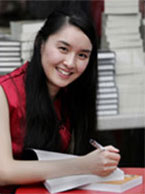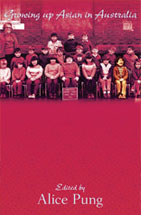
What made you want to edit a collection of stories and essays about growing up Asian in Australia?
My editors at Black Inc and I got together one day and brainstormed this idea, because although Asian–Australians had been in Australia since around 1810, there was such a dearth of stories about their experiences and contributions to this country.
How did you go about selecting which pieces to include?
I concentrated on the period of ‘growing up’ – because that’s the period when most of life’s ‘first’s’ happen – and I also wanted the definition of Asian–Australian to be as diverse and inclusive as possible. I selected pieces that reflected a broad range of Asian–Australian experience, so we have stories ranging from Jenny Kee’s adolescent awakening, to Tony Ayres account of blowing a kiss to a racist skinhead, from Tanveer Ahmed’s hilarious meditation on the exotic rissole to Shalini Akhil’s attempts to be the first ethnically–enhanced Wonder Woman, from Khoa Do’s mentoring of young disadvantaged Australians, to the experiences of the first Asian presenter of Play School – and everything in between.
We have writers like Kylie Kwong and Ken Chau whose ancestors came from the gold rush days in the 1860s and lived through the White Australia Policy, and more recent arrivals who grew up during the era of multiculturalism. We have writers who are Eurasian, adopted, and migrants. I wanted this anthology to encompass as much diverse insight as possible, so our authors come from every walk of life.
Were you surprised by the amount of interest you received in the project after calling for submissions?
I was very happy about the incredible amount of interest received after calling for submissions. Our younger contributors have a wonderful freshness of voice, but we were also especially honoured to receive stories from Asian–Australians from older generations, because they could reflect back on their growing–up years with the wisdom of experience. We also have quite a few stories about how different generations dealt with their parents, and I only wish I had this amount of insight when I was growing up! I also wish there was more room in the anthology to include many more of the stories we received. It was such an honour to read them all.
Are there common themes running through the collection? Do the contributors share a common experience of growing up?
The pieces in this anthology – like Asian–Australians – are so diverse, and the beauty of this book is that it shatters all stereotypes people may have had about Asian–Australians – we have eminent Asian–Australians like Lord Mayor So revealing that he came to Australia to follow in the footsteps of Chinese–American Nobel Physics Prize–winners, stories about Asian–Australians surviving different types of racist bullying throughout the decades and stories of Asian–Australians ‘coming out’ to their parents. What moved me was the resilience of our writers, their creativity, humour, quirk and insight – sometimes against severe racism, personal illness, familial pressure and pressure from society to conform.
Given that this book is all about growing up Asian, would you recommend it to a non–Asian reader?
Although this collection is titled Growing up Asian in Australia, I wanted to bring out the common humanity of our authors, so that any reader could pick up the book and be amused, amazed, moved and heartened. There is often the stereotype of Asian–Australians as the ‘model minority’ (and before that, we were considered the Yellow Peril). What this anthology aims to do is dismantle all these stereotypes and show the incredible diversity of experience of our lives, the humour and insight, the struggles and achievements – these stories should be very much part of the Australian narrative, because they are also very Australian stories.
 Growing Up Asian in Australia
Growing Up Asian in Australia
 Home | Aims and Objectives of Solidarity Philippines Australia Network | About Kasama
Home | Aims and Objectives of Solidarity Philippines Australia Network | About Kasama 
Search the SPAN Web